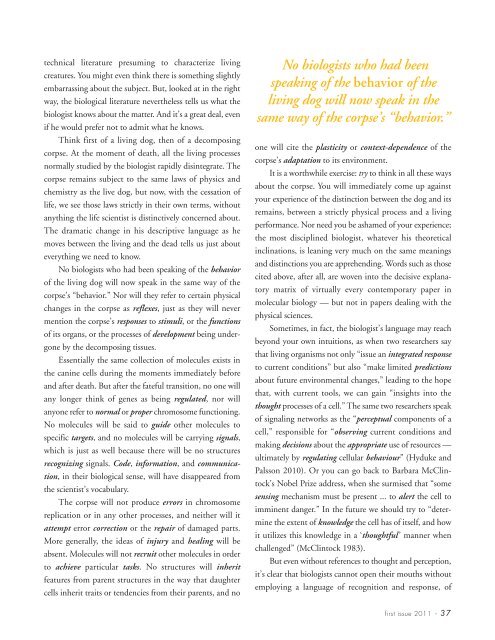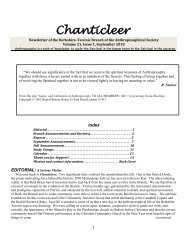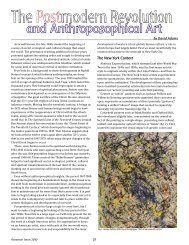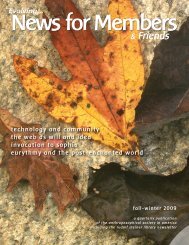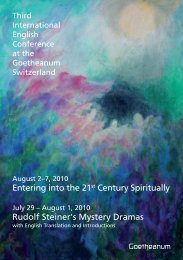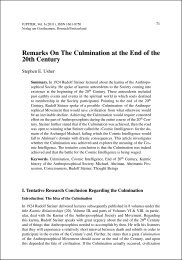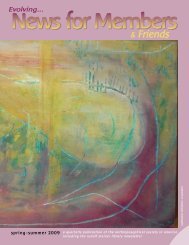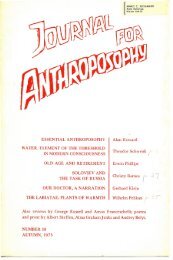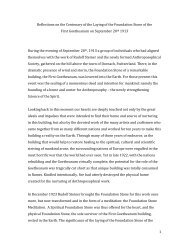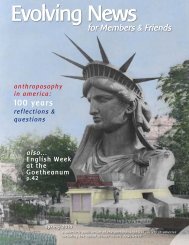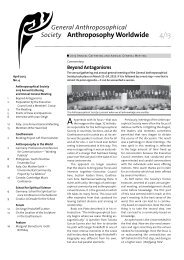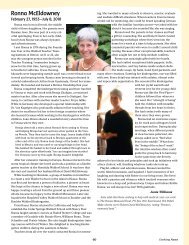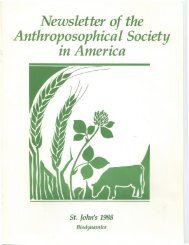Rudolf Steiner's Vision for the Future - Anthroposophical Society in ...
Rudolf Steiner's Vision for the Future - Anthroposophical Society in ...
Rudolf Steiner's Vision for the Future - Anthroposophical Society in ...
Create successful ePaper yourself
Turn your PDF publications into a flip-book with our unique Google optimized e-Paper software.
technical literature presum<strong>in</strong>g to characterize liv<strong>in</strong>g<br />
creatures. You might even th<strong>in</strong>k <strong>the</strong>re is someth<strong>in</strong>g slightly<br />
embarrass<strong>in</strong>g about <strong>the</strong> subject. But, looked at <strong>in</strong> <strong>the</strong> right<br />
way, <strong>the</strong> biological literature never<strong>the</strong>less tells us what <strong>the</strong><br />
biologist knows about <strong>the</strong> matter. And it’s a great deal, even<br />
if he would prefer not to admit what he knows.<br />
Th<strong>in</strong>k first of a liv<strong>in</strong>g dog, <strong>the</strong>n of a decompos<strong>in</strong>g<br />
corpse. At <strong>the</strong> moment of death, all <strong>the</strong> liv<strong>in</strong>g processes<br />
normally studied by <strong>the</strong> biologist rapidly dis<strong>in</strong>tegrate. The<br />
corpse rema<strong>in</strong>s subject to <strong>the</strong> same laws of physics and<br />
chemistry as <strong>the</strong> live dog, but now, with <strong>the</strong> cessation of<br />
life, we see those laws strictly <strong>in</strong> <strong>the</strong>ir own terms, without<br />
anyth<strong>in</strong>g <strong>the</strong> life scientist is dist<strong>in</strong>ctively concerned about.<br />
The dramatic change <strong>in</strong> his descriptive language as he<br />
moves between <strong>the</strong> liv<strong>in</strong>g and <strong>the</strong> dead tells us just about<br />
everyth<strong>in</strong>g we need to know.<br />
No biologists who had been speak<strong>in</strong>g of <strong>the</strong> behavior<br />
of <strong>the</strong> liv<strong>in</strong>g dog will now speak <strong>in</strong> <strong>the</strong> same way of <strong>the</strong><br />
corpse’s “behavior.” Nor will <strong>the</strong>y refer to certa<strong>in</strong> physical<br />
changes <strong>in</strong> <strong>the</strong> corpse as reflexes, just as <strong>the</strong>y will never<br />
mention <strong>the</strong> corpse’s responses to stimuli, or <strong>the</strong> functions<br />
of its organs, or <strong>the</strong> processes of development be<strong>in</strong>g undergone<br />
by <strong>the</strong> decompos<strong>in</strong>g tissues.<br />
Essentially <strong>the</strong> same collection of molecules exists <strong>in</strong><br />
<strong>the</strong> can<strong>in</strong>e cells dur<strong>in</strong>g <strong>the</strong> moments immediately be<strong>for</strong>e<br />
and after death. But after <strong>the</strong> fateful transition, no one will<br />
any longer th<strong>in</strong>k of genes as be<strong>in</strong>g regulated, nor will<br />
anyone refer to normal or proper chromosome function<strong>in</strong>g.<br />
No molecules will be said to guide o<strong>the</strong>r molecules to<br />
specific targets, and no molecules will be carry<strong>in</strong>g signals,<br />
which is just as well because <strong>the</strong>re will be no structures<br />
recogniz<strong>in</strong>g signals. Code, <strong>in</strong><strong>for</strong>mation, and communication,<br />
<strong>in</strong> <strong>the</strong>ir biological sense, will have disappeared from<br />
<strong>the</strong> scientist’s vocabulary.<br />
The corpse will not produce errors <strong>in</strong> chromosome<br />
replication or <strong>in</strong> any o<strong>the</strong>r processes, and nei<strong>the</strong>r will it<br />
attempt error correction or <strong>the</strong> repair of damaged parts.<br />
More generally, <strong>the</strong> ideas of <strong>in</strong>jury and heal<strong>in</strong>g will be<br />
absent. Molecules will not recruit o<strong>the</strong>r molecules <strong>in</strong> order<br />
to achieve particular tasks. No structures will <strong>in</strong>herit<br />
features from parent structures <strong>in</strong> <strong>the</strong> way that daughter<br />
cells <strong>in</strong>herit traits or tendencies from <strong>the</strong>ir parents, and no<br />
No biologists who had been<br />
speak<strong>in</strong>g of <strong>the</strong> behavior of <strong>the</strong><br />
liv<strong>in</strong>g dog will now speak <strong>in</strong> <strong>the</strong><br />
same way of <strong>the</strong> corpse’s “behavior.”<br />
one will cite <strong>the</strong> plasticity or context-dependence of <strong>the</strong><br />
corpse’s adaptation to its environment.<br />
It is a worthwhile exercise: try to th<strong>in</strong>k <strong>in</strong> all <strong>the</strong>se ways<br />
about <strong>the</strong> corpse. You will immediately come up aga<strong>in</strong>st<br />
your experience of <strong>the</strong> dist<strong>in</strong>ction between <strong>the</strong> dog and its<br />
rema<strong>in</strong>s, between a strictly physical process and a liv<strong>in</strong>g<br />
per<strong>for</strong>mance. Nor need you be ashamed of your experience;<br />
<strong>the</strong> most discipl<strong>in</strong>ed biologist, whatever his <strong>the</strong>oretical<br />
<strong>in</strong>cl<strong>in</strong>ations, is lean<strong>in</strong>g very much on <strong>the</strong> same mean<strong>in</strong>gs<br />
and dist<strong>in</strong>ctions you are apprehend<strong>in</strong>g. Words such as those<br />
cited above, after all, are woven <strong>in</strong>to <strong>the</strong> decisive explanatory<br />
matrix of virtually every contemporary paper <strong>in</strong><br />
molecular biology — but not <strong>in</strong> papers deal<strong>in</strong>g with <strong>the</strong><br />
physical sciences.<br />
Sometimes, <strong>in</strong> fact, <strong>the</strong> biologist’s language may reach<br />
beyond your own <strong>in</strong>tuitions, as when two researchers say<br />
that liv<strong>in</strong>g organisms not only “issue an <strong>in</strong>tegrated response<br />
to current conditions” but also “make limited predictions<br />
about future environmental changes,” lead<strong>in</strong>g to <strong>the</strong> hope<br />
that, with current tools, we can ga<strong>in</strong> “<strong>in</strong>sights <strong>in</strong>to <strong>the</strong><br />
thought processes of a cell.” The same two researchers speak<br />
of signal<strong>in</strong>g networks as <strong>the</strong> “perceptual components of a<br />
cell,” responsible <strong>for</strong> “observ<strong>in</strong>g current conditions and<br />
mak<strong>in</strong>g decisions about <strong>the</strong> appropriate use of resources —<br />
ultimately by regulat<strong>in</strong>g cellular behaviour” (Hyduke and<br />
Palsson 2010). Or you can go back to Barbara McCl<strong>in</strong>tock’s<br />
Nobel Prize address, when she surmised that “some<br />
sens<strong>in</strong>g mechanism must be present ... to alert <strong>the</strong> cell to<br />
imm<strong>in</strong>ent danger.” In <strong>the</strong> future we should try to “determ<strong>in</strong>e<br />
<strong>the</strong> extent of knowledge <strong>the</strong> cell has of itself, and how<br />
it utilizes this knowledge <strong>in</strong> a ‘thoughtful’ manner when<br />
challenged” (McCl<strong>in</strong>tock 1983).<br />
But even without references to thought and perception,<br />
it’s clear that biologists cannot open <strong>the</strong>ir mouths without<br />
employ<strong>in</strong>g a language of recognition and response, of<br />
first issue 2011 • 37


